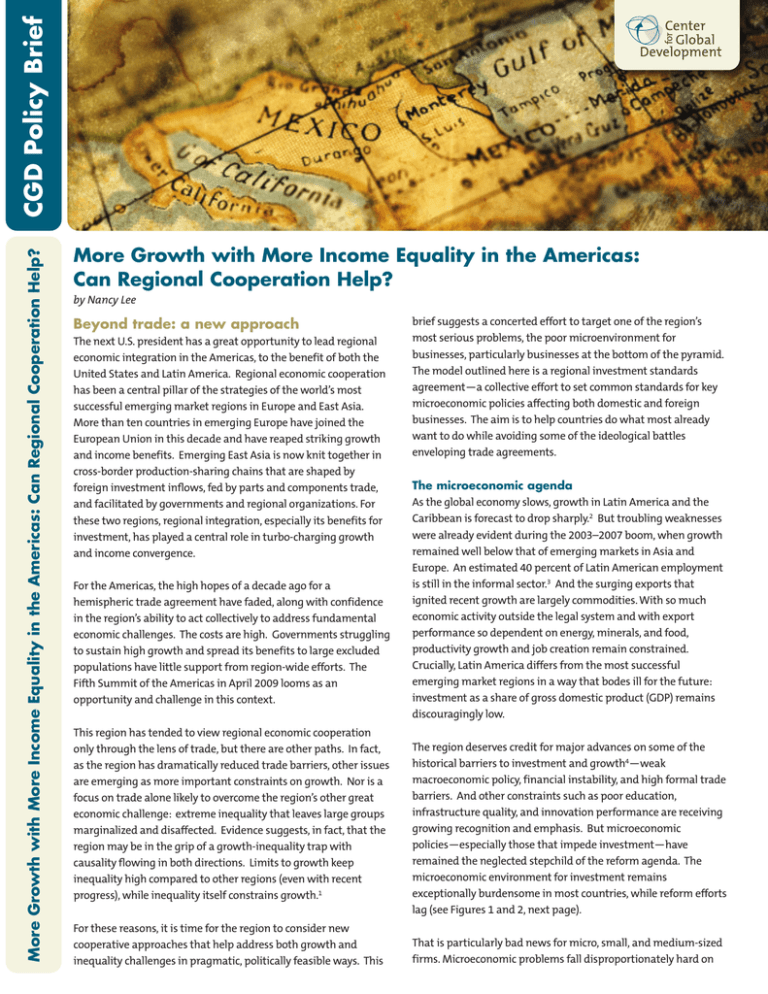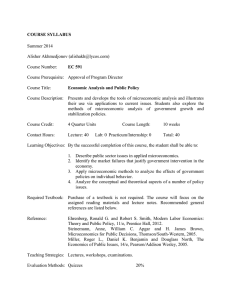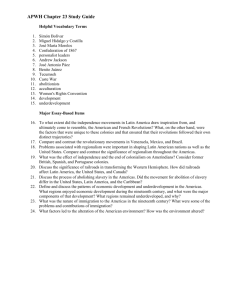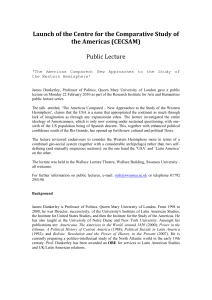f e ri B
advertisement

CGD Policy Brief More Growth with More Income Equality in the Americas: Can Regional Cooperation Help? More Growth with More Income Equality in the Americas: Can Regional Cooperation Help? by Nancy Lee Beyond trade: a new approach The next U.S. president has a great opportunity to lead regional economic integration in the Americas, to the benefit of both the United States and Latin America. Regional economic cooperation has been a central pillar of the strategies of the world’s most successful emerging market regions in Europe and East Asia. More than ten countries in emerging Europe have joined the European Union in this decade and have reaped striking growth and income benefits. Emerging East Asia is now knit together in cross-border production-sharing chains that are shaped by foreign investment inflows, fed by parts and components trade, and facilitated by governments and regional organizations. For these two regions, regional integration, especially its benefits for investment, has played a central role in turbo-charging growth and income convergence. For the Americas, the high hopes of a decade ago for a hemispheric trade agreement have faded, along with confidence in the region’s ability to act collectively to address fundamental economic challenges. The costs are high. Governments struggling to sustain high growth and spread its benefits to large excluded populations have little support from region-wide efforts. The Fifth Summit of the Americas in April 2009 looms as an opportunity and challenge in this context. This region has tended to view regional economic cooperation only through the lens of trade, but there are other paths. In fact, as the region has dramatically reduced trade barriers, other issues are emerging as more important constraints on growth. Nor is a focus on trade alone likely to overcome the region’s other great economic challenge: extreme inequality that leaves large groups marginalized and disaffected. Evidence suggests, in fact, that the region may be in the grip of a growth-inequality trap with causality flowing in both directions. Limits to growth keep inequality high compared to other regions (even with recent progress), while inequality itself constrains growth.1 For these reasons, it is time for the region to consider new cooperative approaches that help address both growth and inequality challenges in pragmatic, politically feasible ways. This brief suggests a concerted effort to target one of the region’s most serious problems, the poor microenvironment for businesses, particularly businesses at the bottom of the pyramid. The model outlined here is a regional investment standards agreement—a collective effort to set common standards for key microeconomic policies affecting both domestic and foreign businesses. The aim is to help countries do what most already want to do while avoiding some of the ideological battles enveloping trade agreements. The microeconomic agenda As the global economy slows, growth in Latin America and the Caribbean is forecast to drop sharply.2 But troubling weaknesses were already evident during the 2003–2007 boom, when growth remained well below that of emerging markets in Asia and Europe. An estimated 40 percent of Latin American employment is still in the informal sector.3 And the surging exports that ignited recent growth are largely commodities. With so much economic activity outside the legal system and with export performance so dependent on energy, minerals, and food, productivity growth and job creation remain constrained. Crucially, Latin America differs from the most successful emerging market regions in a way that bodes ill for the future: investment as a share of gross domestic product (GDP) remains discouragingly low. The region deserves credit for major advances on some of the historical barriers to investment and growth4—weak macroeconomic policy, financial instability, and high formal trade barriers. And other constraints such as poor education, infrastructure quality, and innovation performance are receiving growing recognition and emphasis. But microeconomic policies—especially those that impede investment—have remained the neglected stepchild of the reform agenda. The microeconomic environment for investment remains exceptionally burdensome in most countries, while reform efforts lag (see Figures 1 and 2, next page). That is particularly bad news for micro, small, and medium-sized firms. Microeconomic problems fall disproportionately hard on Nancy Lee was a visiting fellow at CGD from November 2007 to October 2008. She has since returned to the U.S. Treasury where she has served most recently as deputy assistant secretary for Europe, Eurasia and the Western Hemisphere and as director of the Offices of Central and Eastern Europe and of the Mideast and Central Asia. She holds a Ph.D. in economics from Tufts University. The White House and The World Each day brings fresh evidence that Americans’ well-being is linked to the lives of others around the world as never before. Accelerating advances in technology and the creation of new knowledge offer undreamed-of opportunities. Yet global poverty, inequality, disease and the threat of rapid climate change threaten our hopes. How will the U.S. president elected in November 2008 tackle these global challenges? The White House and the World: A Global Development Agenda for the Next U.S. President shows how modest changes in U.S. policies could greatly improve the lives of poor people in developing countries, thus fostering greater stability, security, and prosperity globally and at home. Center for Global Development experts offer fresh perspectives and practical advice on trade policy, migration, foreign aid, climate change and more. In an introductory essay, CGD president Nancy Birdsall explains why and how the next U.S. president must lead in the creation of a better, safer world. The White House and the World Policy Briefs present key facts and recommendations drawn from the book in a succinct form designed for busy people, especially senior policymakers in the executive and legislative branches of government. This brief is drawn from “Integration in the Americas: One Idea for Plan B” by Nancy Lee. The White House and the World Policy Briefs were made possible by the Connect US Fund of the Tides Foundation, by Edward Scott Jr., the chairman of CGD’s board, and by others whose unrestricted funding makes such collaborative and cross-cutting work possible. them in light of their limited political influence and resources.5 Attacking these problems would likely help reduce income inequality (which in turn would boost growth) by shrinking informality, aiding newcomers to formal product and capital markets, and boosting the productivity of the poor and near-poor. A race to the bottom? The stalled race to the top is not the region’s only microeconomic policy problem. There are also growing fears of a race to the bottom. The concern that harmful tax and regulatory competition gives other countries an unfair competitive advantage over U.S.based firms and workers is fueling opposition in the United States to new trade agreements.6 And in Central America, finance officials already struggle with the fiscal effects of tax holidays aimed at luring foreign investors away from neighboring states. Cooperation to agree on sound common standards would help solve this collective action challenge. A regional investment standards agreement Regional cooperation could play a powerful role in addressing these problems. The proposal is a collective regional effort to set sound and fair standards for improving key microeconomic policies. Such standards could simplify and expedite systems for starting a business, paying taxes, obtaining licenses, registering property, dealing with border controls, and accessing credit and infrastructure services. This approach is made possible by the enormous leap forward in the world’s capacity to measure the microeconomic environment for investment using objective, verifiable indicators that are consistent across countries and regularly updated by third-party institutions like the World Bank.7 Examples of such objective indicators range from the official costs of starting a business, to the size of minimum capital requirements for new companies, to the number of procedures needed to obtain licenses, to the number of business tax payments required annually, to the time required to clear customs. Countries participating in the agreement could collectively set standards for such indicators using international norms. To choose norms, they might consider existing best practice in the region, practice in East Asia and Europe, or practice in the member countries of the Organisation for Economic Co-operation and Development (OECD). The aim would not be to impose uniformity on country regulatory and tax systems but rather to promote adherence to a universally applicable set of principles such as simplification, transparency, cost reduction, and time limits: Simplification: Systems should be as simple as possible in terms of the numbers of steps, documents, and approvals needed. Transparency and use of computerized systems: Regulations, documents, forms, and procedures should be standardized and Figure 2. Share of countries making at least one positive business climate reform in 2007/8 Figure 1. Business climate indicators for Latin America and Caribbean countries, 2007–08 120 Average Rank (of 181 Countries) 90 80 100 Overall ease of doing business score 70 80 60 50 60 40 40 30 20 20 10 published on websites, along with the authorities responsible for decision-making and enforcement. Online filing, applications, and approvals would limit discretion and scope for corruption. Reduction of direct costs and fees: Fees charged for procedures and approvals should be kept as low as possible and made transparent. Time limits: Reasonable limits should be set on the time needed for approvals and decisions. The World Bank’s annual Doing Business reports demonstrate that reforms consistent with these principles are well within the reach of both low- and middle-income countries. The gains may be very large indeed. When Azerbaijan, the world’s top Doing Business reformer for 2007/08, halved the time, cost, and number of procedures to start a business, business registrations shot up by 40 percent in the next six months.8 Cross-country studies suggest that major and comprehensive improvements in developingcountry regulatory quality could boost per capita annual growth rates by around 2 percentage points.9 And a better regulatory environment would likely substantially boost the growth response Latin Amercia and Caribbean High Income OECD South Asia Sub-Saharan Africa East Asia Pacific Middle East and North Africa Geting Credit Dealing with Permits Protecting Investors Trading Across Borders Employing Workers Registering Property Starting a Business Closing a Business Paying Taxes Enforcing Contracts Source:World Bank, Doing Business 2009: Overview (Washington, D.C., 2008). Eastern Europe and Central Asia 0 0 to lower trade barriers.10 A regional investment standards agreement would therefore complement and expand the benefits of bilateral and sub-regional trade agreements. Beyond reciprocity Experience with trade agreements demonstrates that regional and multilateral agreements can help drive and lock-in reform and increase its benefits. They can spur countries to mobilize the machinery of government to strengthen implementation. And they can better inform investors of policy progress through a transparent negotiation process. Further, they give private sectors a vehicle for lobbying governments for improvements. This approach shares these benefits, but it would depart from the reciprocal logic of trade agreements. Trade agreements involve an exchange of concessions; that is, countries lower their barriers to imports in return for reciprocal reductions in barriers to their exports. Under this approach, in contrast, a country's self-interest and the collective interest merge. Good region-wide standards would benefit the home country’s firms, foreign firms investing in the home country, and home-country firms investing in the CGD Policy Brief region. Positive externalities accompany regional or multilateral improvements in the tax and regulatory environments. Recognition of such benefits led Europe to move beyond reducing trade barriers to harmonizing systems. And it led financial regulators to agree on common capital adequacy standards in the Basel Accords. Coordinated improvements in microeconomic conditions of the sort that could be achieved by this kind of agreement could accelerate development in this hemisphere of the intra-industry supply chains that have driven and spread growth in East Asia. And faster investment-led growth in the neighborhood pulls others along; growth is not a zero-sum game. What kind of countries might participate? Those motivated by one or more of the following considerations. They would likely be focused on shrinking large informal sectors; be interested in establishing and expanding regional production chains; want to promote increased inward foreign direct investment, especially in manufacturing and services; have domestic businesses interested in more outward investment within the region; benefit from an external reform driver; seek to forestall a race to the bottom. Promoting compliance and participation How would compliance be fostered? A gamut of soft to hard options could be considered to promote adherence to agreement commitments. The simplest and least intrusive approach would be to establish annual national or third-party reporting on country progress. A notch up on the surveillance scale would be a system of peer review, with countries gathering regularly to discuss each other’s progress and perhaps issue assessments. The most ambitious approach would provide investors recourse to arbitration against a country that fails to comply with agreedupon standards. This process could serve domestic as well as foreign investors, if consistent with domestic law. In cases where states do not honor arbitration judgments, foreign investors could request their home countries to pursue state-to-state arbitration as a backup means of promoting compliance. To encourage participation, an agreement might contain the following incentives: Transition periods and capacity-building assistance. The standards laid down in the agreement must be set relatively high, but countries should be allowed generous transition periods and ample technical assistance to meet them. This assistance could be provided by participating countries that already meet the standards, by international financial institutions, or both. Countries should also be allowed to opt out of some standards, such as labor regulations, on which they may have very divergent views. Streamlined access to multilateral development bank funds for infrastructure financing and for small- and medium-sized enterprises. By agreeing to uphold these standards, countries would become more attractive and less risky to investors, including the private sector investment arms of multilateral development banks (MDBs). The standards would allow MDBs to speed up often time-consuming project analysis of macroeconomic and microeconomic policy risks, as well as Do Businesses Worry About Microeconomic Barriers? Fifty-three percent of regional businesses surveyed cite regulatory and tax systems as the main obstacles to doing business. Non-transparent and burdensome regulatory and tax systems confront businesses with a harmful choice between remaining in the informal sector or resorting to bribes. The graph below shows the percentage of firms in Latin America and the Caribbean that cited a given problem as their main obstacle to doing business. The obstacles that would be addressed by this proposal are grouped on the left. Customs and trade regulations (2.2%) Business licensing and operating permits (3.4%) Labor regulations (4.0%) Crime, theft, and disorder (10.9%) Tax administration (5.1%) Political instability (9.9%) Tax rates (9.1%) Access to financing (availability and cost) (9.7%) Corruption (11.4%) Electricity (6.9%) Informality (18.1%) Skills and education of available workers (6.5%) Transportation of goods, supplies, and inputs (1.1%) Courts (0.9%) Access to land (0.8%) Source: adapted from World Bank, Enterprise Surveys database (Washington, D.C., 2006). More Growth with More Income Equality in the Americas: Can Regional Cooperation Help? operational risks. The agreement standards would also make it possible for MDBs to raise their estimates of risk-adjusted returns for some projects and make them eligible for investment. Access to arbitration. In the context of multilateral agreements, enforcement capability is probably valued as much as the quality of commitments. Firms’ interest in having their governments participate in such an effort would be heightened by the inclusion of arbitration rights. Governments themselves would likely be conflicted, reluctant to submit themselves to arbitration while interested in the option of taking other governments that fail to honor commitments to court. Launching discussions To launch this effort, interested countries could begin by calling for exploratory discussions to define options for the scope and structure of an agreement that could generate broad support. Such a call might logically come from those countries already focused on investment reforms but interested in expanding their benefits. Colombia, the Dominican Republic, Guatemala, Mexico, and Peru, for example, have been named among the top ten global reformers by the World Bank in its Doing Business reports, while Chile ranks fortieth in the world on the ease of doing business, the highest in Latin America.11 The next U.S. president could play a crucial role by responding quickly to an initiative from interested countries. The United States would have much to gain from a successful agreement which could significantly boost the region’s contribution to U.S. growth and help level the regional playing field in areas such as environmental and labor standards. The United States should encourage regional institutions like the Inter-American Development Bank to host exploratory discussions involving both governments and businesses and to provide essential technical input as it did in the early days of the FTAA discussions. The United States can also play a critical role by taking the lead in mobilizing aid to help countries build capacity to meet the agreed-upon standards. The Summit of the Americas next year provides an important opportunity for leaders to move forward on an investment standards agreement among interested countries. In the likely absence of near-term agreement on resuming negotiations on the Free Trade Area of the Americas, the pursuit of such a pact could supply a new way forward for the countries of the hemisphere to increase growth and reduce inequality. www.cgdev.org Further Reading Nancy Lee. 2008. "Integration in the Americas: One Idea for Plan B." In The White House and the World: A Global Development Agenda for the Next U.S. President. Nancy Birdsall, editor. Washington, D.C.: Center for Global Development. Nancy Birdsall, Augusto de la Torre, and Rachel Menezes. 2008. Fair Growth: Economic Policies for Latin America’s Poor and Middle-Income Majority. Washington, D.C.: Center for Global Development and the Inter-American Dialogue. Jerry Haar and John Price, eds. 2008. Can Latin America Compete? Confronting the Challenges of Globalization. New York: Palgrave Macmillan. Guillermo Perry et al. 2007. Informality: Exit and Exclusion. Washington, D.C.: World Bank. World Bank. 2008. Doing Business 2009: Overview. Washington, D.C.: World Bank. Endnotes 1 See, for example, Birdsall, de la Torre, and Menezes, Fair Growth: Economic Policies for Latin America’s Poor and Middle-Income Majority (Washington, D.C.: Center for Global Development and the Inter-American Dialogue, 2008); IDB (Inter-American Development Bank), Facing Up to Inequality in Latin America, Economic and Social Progress Report (Washington: Inter-American Development Bank, 1999); Perry, “High Inequality,”Americas Quarterly (Spring 2008). 2 The October 2008 IMF World Economic Outlook forecasts growth at 3.2 percent for the region in 2009, down from 4.6 percent in 2008. 3 ILO (International Labour Organization). Panorama laboral de América Latina y el Caribe (Lima: International Labour Organization, Regional Office for Latin America and the Caribbean, 2007). 4 Jeromin Zettelmeyer, “Growth and Reforms in Latin America: A Survey of Facts and Arguments,”Working Paper No. 06/210 (Washington, D.C.: International Monetary Fund, 2006). 5 Birdsall, de la Torre, and Menezes, Fair Growth. 6 Lawrence Summers, “A Strategy to Promote Healthy Globalization,”Financial Times (May 5, 2008). 7 Recent criticism of the World Bank’s Doing Business indicators has focused on measurement issues, differences of view on regulatory benefits, particularly for labor regulation, and the need to avoid downplaying the significance of other investment climate factors like macroeconomic and political stability. These are important issues, but the indicators remain useful for the purpose of setting common microeconomic standards, especially as measurement problems are addressed by the World Bank. 8 World Bank, Doing Business 2009: Overview (Washington, D.C.:World Bank, 2008). 9 See, for example, Djankov, McLeish, and Ramalho, Regulation and Growth (Washington, D.C.:World Bank, 2006); Loayza, Oviedo, and Servén, “Regulation and Macroeconomic Performance,”in Loayza and Servén, eds., Microeconomic Underpinnings of Growth (Washington, D.C:World Bank, 2008). 10 See Bolaky and Freund, “Trade, Regulations, and Growth,”Policy Research Working Paper No. 3255 (Washington, D.C.:World Bank, 2004); Haar and Price, eds., Can Latin America Compete? Confronting the Challenges of Globalization (New York: Palgrave Macmillan, 2008) 11 World Bank, Doing Business.





